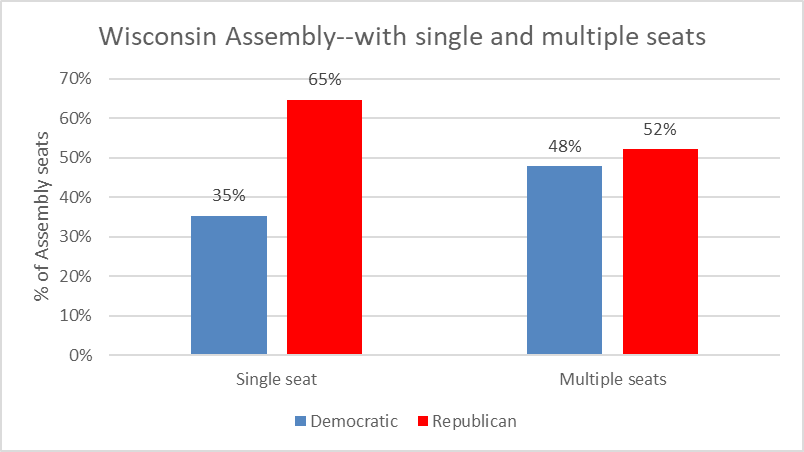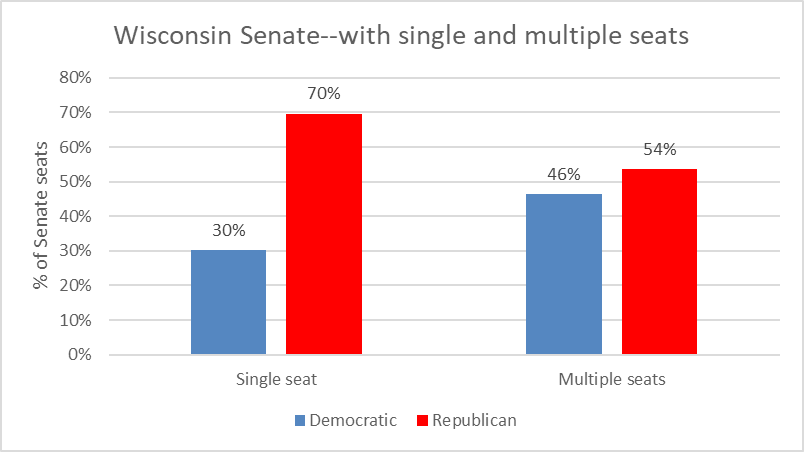Multiple Representatives Would Lessen Gerrymandering
If every Assembly district had 3 representatives rather than 1 the result would be dramatic.

A yard sign in Mellen, Wisconsin reads: “This Time Wisconsin Deserves Fair Maps,” paid for by the Fair Elections Project, FairMapsWI.com. The political sign supports redistricting legislation to reform gerrymandering. Wisconsin Fair Maps Coalition by Tony Webster (CC BY 2.0) https://creativecommons.org/licenses/by/2.0/
In recent years, American politics has become increasingly polarized, particularly on the right. The recent election confirms that voters in Wisconsin are evenly split between the parties. Of the five state-wide posts at stake, Democrats won three and Republicans two.
Yet, under a Republican-designed gerrymander, the Wisconsin Legislature seems more typical of a one-party state. The subtitle on a recent article states that “a right-wing minority has outsized power in the House today.” Although this article is referring to the US House, it is very relevant to the situation in Wisconsin.
To test the effect of multiple legislators in a district, I assumed that three individuals would be elected to each district, using a ranked choice mechanism. In this voters would first rank the candidates in order of preference. If no candidate received at least one third of the vote, the candidate receiving the smallest number of votes would be eliminated. That candidate’s votes would be transferred to the voter’s next choices. This process would be repeated until all three positions were filled.
In doing the analysis, I assumed a highly polarized electorate, in which Democrats’ first, second, and third choices were Democratic candidates, and the same rule held for Republicans.
The table below shows the candidate preferences in a typical Wisconsin legislative district. Rather than the typical single legislator districts used today in the state, it is assumed that three legislators will represent each Senate or Assembly district.
The hypothetical example below assumes that 40% of the voters vote Democratic and 60% vote Republican. Six candidates are running for the three seats, three Democrats, designated as D1, D2, and D3, and three Republicans, R1, R2, and R3. The chart below shows the voters first choice, so that 20% of the voters choose candidate D1, and so forth. If the first is not available, voters choose another candidate with the same party.

First choice of voters
None of the candidates enjoy the support of at least one-third of the voters. Instead, D3, the candidate with the least support, is eliminated. D3’s support is transferred to those voters’ second choice, D1. The result is shown below.

Round 1
Still, no candidate gets at least one third of the votes, so the next lowest candidate, R3, is eliminated and the votes transferred to R1.

round 2a
As a result R1 now has 40% of the total, more than the 33.3% needed to win the first of the three seats. The excess, 6.7% of votes, goes to the voters’ second choice, R2. The result is shown in the table below.

Round 2b
D2 has the next lowest count and is eliminated, with its votes transferred to D1. That gives D1 sufficient votes to claim the district’s second seat.
At this point, R2 is the only candidate that has not either been eliminated or won a seat. Thus, R2 wins the last of the three seats in the district. The result in most circumstances is a district that is safely Republican today would have two Republican legislators and one Democrat legislator under a multiple representative regime. Similarly, most districts currently with a single Democratic legislator would elect two Democrats and one Republican.
There is, however, an exception to this pattern if one party’s share of the vote is below 16.7% (1/6) of the vote. In that case, the other party wins all three of the seats.
In the present Wisconsin Legislature, eight of the 99 House districts would likely have three Democratic members based on this rule of thumb. By contrast, there would be no districts with three Republicans. At first glance, this might be viewed as a Democratic advantage. In truth, such intensely Democratic districts are a major tool in the Republican-designed gerrymander. “Packing” Democratic voters in a few districts allows the creation of a greater number of Republican-favored districts.
Under the single member configuration with a tied vote, about 35% of the representatives are Democratic compared to 65% for Republicans. Even with a tied vote, Republicans end up with an overwhelming majority, one close to be veto proof.
With multiple members, the gap narrows substantially, from 30% to 4%. This is true even though the gerrymander remains in effect.

Wisconsin Assembly with single and multiple seats
A similar story is told by the Senate. With multiple members, the gap shrinks from 40 percentage points, a veto-proof majority to 8 points, as the next graph shows.

Wisconsin Senate with single and multiple seats
The article I referenced at the start of this column claims that with proportional representation, the problem of a right-wing minority with outsized power would be much less likely.” Before undertaking this analysis, I was skeptical of their statement.
Several caveats are necessary. One is that having three representatives per district could make an unwieldy Legislature. It would probably be necessary to shrink the number of Senate and Assembly districts.
The most important caveat: it is extremely unlikely that the people in charge of Wisconsin’s laws—the Legislature and the current Supreme Court majority–will decide that democracy should take precedence over continued Republican control. No reform, whether multiple representation or more fairly drawn legislative districts, is likely in the event a Republican-backed conservative wins the upcoming Supreme Court election.
If you think stories like this are important, become a member of Urban Milwaukee and help support real, independent journalism. Plus you get some cool added benefits.
Data Wonk
-
Why Absentee Ballot Drop Boxes Are Now Legal
 Jul 17th, 2024 by Bruce Thompson
Jul 17th, 2024 by Bruce Thompson
-
The Imperial Legislature Is Shot Down
 Jul 10th, 2024 by Bruce Thompson
Jul 10th, 2024 by Bruce Thompson
-
Counting the Lies By Trump
 Jul 3rd, 2024 by Bruce Thompson
Jul 3rd, 2024 by Bruce Thompson





















This is an outstanding idea.
In New Hampshire there are 400 state representatives. On average, each legislator represents about 3,300 residents, which is the smallest lower house representative-to-population ratio in the country. It has by far the largest lower house of any American state. The second-largest, the Pennsylvania House of Representatives, has 203 members.
Also, New Hampshire legislators earn $100 per year without a per diem.